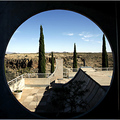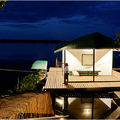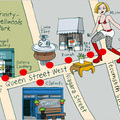Great Space, Glass Floor-Through, Canyon Views
GRAND CANYON WEST, Ariz. — A visitor to these stark and imposing lands of the Hualapai Indians on the western rim of the Grand Canyon knows what sensation is being promised at the journey’s climax. After driving for a half-hour over bone-jolting dirt roads some 120 miles from Las Vegas, you take a shuttle bus from the parking lot, not far from where helicopters are landing, and construction is proceeding. You deposit all cameras at a security desk, slip on yellow surgical booties and stride out onto a horseshoe-shaped walkway with transparent sides and walls that extends 70 feet into space, seemingly unsupported.
Below the floor’s five layers of glass (protected from scratches by the booties) can be seen the cracked, sharp-edged rock face of the canyon’s rim and a drop of thousands of feet to the chasm below. The promise is the dizzying thrill of vertigo.
And indeed, last week some visitors to this steel-supported walkway anchored in rock felt precisely that. One woman, her left hand desperately grasping the 60-inch-high glass sides and the other clutching the arm of a patient security guard, didn’t dare move toward the transparent center of the walkway. The words imprinted on the $20 souvenir photographs taken of many venturesome souls herald completion of a daredevil stunt: “I did it!!!”
The Skywalk, which opened in March and cost more than $30 million, will end up paying for itself if it keeps fulfilling that promise of amusement park vertigo, particularly because each visitor taking the brief walk over the abyss must pay at least $74.95 for a tour package. But a similar thrill can be had with greater intensity just a hundred yards away on ordinary ground, where tourists tentatively edge toward a precipice without guardrail or fence, and look across the ravine at a great rock formation that bears some resemblance to a giant eagle, its wings outspread. In that spot the sense of grandeur is far more palpable than on the pedestrian walkway, which within a few moments can seem as routine as a glass-bottom boat in the Caribbean.
Moreover, when leaning over that nearby stone ledge, the frisson of danger is more properly mixed with another sentiment that has long lured viewers to the great south rim of the Grand Canyon: a sense of awe at the expanse of space, and the humbling sense of something sublime, lying beyond the grasp of human capacities. The Skywalk, with its peach-colored industrial-style supports under its glass floor, doesn’t come close.
To be frank, even the stunning view off the Hualapai ledge does not hold up to a comparison with the south or north rims, which are controlled by the National Park Service. The stone eagle, like the Skywalk itself, does not actually hover over the Grand Canyon but over a subsidiary tributary canyon. The distance straight down is also less than the 4,000 feet to the Colorado River mentioned in promotional material. And the vista itself, however grand, is less shockingly immense and overwhelming than those in the more famous areas of the park. Even the colors are less variegated.
What is being offered instead is another kind of lure, sensed in the personal appeal of one of the site’s hosts, Wilfred Whatoname, a former tribal policeman and environmental officer, who proudly affirms his tribal affiliation with the feathers in his hair. He poses for photos, generously offering help to visitors. “We’re in the realm of the eagle,” he says, facing the canyon, his arms outstretched to embrace the updraft.
His picture also appears on the side of every Hualapai shuttle bus. He is shown gazing out at the new Skywalk, while below him, a helicopter and a Hummer romp near a motorized raft on the Colorado River. The portrait, like the Skywalk itself, manages to invoke both a romantic image of the American Indian — preternaturally close to the land, its past and its powers — while promising the kind of activities that have been banned from the main part of the canyon by the Park Service.
In fact, look more closely at Grand Canyon West, and it is as if the roles of the United States government and the Indian tribes had been inverted or exchanged. The Park Service takes an almost sacred view of the canyon landscape, as if drawing on an imagined Indian conception of the land, striving to protect it from encroaching pressures, noise and commerce brought by nearly five million annual visitors. The Park Service does not permit anything resembling the Hualapai Hummer off-road tours; it has banned helicopter flights below the canyon’s rim, like the ones the Hualapai offer. And it would not permit a permanent horseshoe of steel and glass to protrude into the canyon.
Meanwhile, the Hualapai are doing just the opposite, striving to increase commerce by exploiting the land’s allure, adopting the most cliché-ridden tactics of Wild West tourism. Every Skywalk visitor’s tour package even includes a visit to a mock Western town — the Hualapai Ranch — complete with a (dry) saloon and (empty) jail, staged gunfights and “Cowboy cookin’.”
Near the Skywalk there is a new Indian “village” that is not really a village at all but a miscellaneous assemblage of Indian dwellings constructed by local tribes: a Navajo mud-covered “sweat lodge,” a Hopi stone house, a Hualapai “wikiup” teepee constructed of juniper logs.
Folk dances reflecting various tribal cultures are also performed, sometimes reproducing historical styles, sometimes offering modern variations in elaborate tribal dress. There is minimal explanation of the dances and their functions, or of the nature of any real Indian village, or of the history of these tribes. The Skywalk repackages nature; these exhibitions repackage imagery.
The motivation of all this is clear enough. The Hualapai, with barely 2,000 members, control almost a million acres of land along the Colorado, granted them in 1883. In many early documents they are described as poverty-stricken and desirous of self-improvement, and both characteristics seem to have persisted. Gambling has failed as a commercial lure, since Las Vegas is just a three-hour drive away. So tourism accounts for 70 percent of the tribal budget.
Only about 400 daily visitors came to Grand Canyon West before the Skywalk opened. Now, a tribal spokesman said, there are about 1,500. By year’s end, plans call for the paving of miles of dirt road, expansion of the local airstrip to accommodate commercial jets and the construction of a cafe, a restaurant, an Imax theater and a visitors’ center over the entrance to the Skywalk. The hope is for 5,000 to 6,000 daily visitors.
Money for the Skywalk was invested by a Las Vegas entrepreneur, David Jin, whose tour company also regularly brings Asian visitors to the site. But future development will have its challenges: the area now has its water and waste hauled in and out, while diesel generators and solar panels supply electricity; that frail infrastructure will be far more strained if the Skywalk complex draws huge crowds.
The entire enterprise has been fraught with controversy. There were tribal members, including Mr. Whatoname, who opposed the development out of a belief in the sacredness of the canyon. But he now says it may have been worth it if it serves the long-term survival of the tribe.
But at what cost — to all? The tribe’s repackaging of the natural world seems uninspired, hasty, expensive. After paying $74.95 for the “Spirit Package” with its Skywalk feature, a visitor can spend $125 more for a brief helicopter ride down to the Colorado, followed by a nondescript 20-minute jaunt in a motorized launch and another brief helicopter trip up.
I took the plunge, sitting in a cramped back seat of the helicopter, trying to glimpse the canyon walls through a window that seemed barely larger than a porthole; below, at river level, the drone of choppers ferrying other tourists provided constant accompaniment to the looming appearance of mammoth, layered rock formations, once chiseled by the now muddy, sluggishly flowing river.
Too much for too little. And unlike the areas overseen by the Park Service, there are no hiking paths, no ways to escape crowds or commerce and begin to see something else.
Perhaps that will change as this fledgling enterprise expands, but for now, an Indian tribe and representatives of its onetime nemesis have exchanged roles. The Hualapai are leading Wild West spectacle tours, while the Park Service is guardian of the ancient earth. Each is taking on ways of thinking about the natural world that were once associated with the other. And that inspires more vertigo than the Skywalk.





